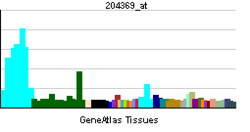- P110α
-
The p110α protein is a class I PI 3-kinase catalytic subunit. The human p110α protein is encoded by the PIK3CA gene.[1]
Contents
Function
Phosphatidylinositol 3-kinase is composed of an 85 kDa regulatory subunit and a 110 kDa catalytic subunit. The protein encoded by this gene represents the catalytic subunit, which uses ATP to phosphorylate phosphatidylinositols (PtdIns), PtdIns4P and PtdIns(4,5)P2.[2]
Clinical significance
This gene has been found to be oncogenic and has been implicated in cervical cancers.[3] Recent evidence has shown that the PIK3CA gene is mutated in a range of human cancers. Due to the association between p110α and cancer[4] it is believed to be a promising drug target. A number of pharmaceutical companies are currently designing and charactering potential p110α isoform specific inhibitors.[5][6]
See also
Interactions
P110α has been shown to interact with ARHGEF1,[7] Centaurin, alpha 1,[8] DGKZ,[9] Lck[10][11] and HRAS.[12][13][14]
References
- ^ Hiles ID, Otsu M, Volinia S, Fry MJ, Gout I, Dhand R, Panayotou G, Ruiz-Larrea F, Thompson A, Totty NF (August 1992). "Phosphatidylinositol 3-kinase: structure and expression of the 110 kd catalytic subunit". Cell 70 (3): 419–29. doi:10.1016/0092-8674(92)90166-A. PMID 1322797.
- ^ "Entrez Gene: PIK3CA". http://www.ncbi.nlm.nih.gov/sites/entrez?Db=gene&Cmd=ShowDetailView&TermToSearch=5290.
- ^ Ma YY, Wei SJ, Lin YC, Lung JC, Chang TC, Whang-Peng J, Liu JM, Yang DM, Yang WK, Shen CY (May 2000). "PIK3CA as an oncogene in cervical cancer". Oncogene 19 (23): 2739–44. doi:10.1038/sj.onc.1203597. PMID 10851074.
- ^ Samuels Y, Wang Z, Bardelli A, Silliman N, Ptak J, Szabo S, Yan H, Gazdar A, Powell SM, Riggins GJ, Willson JK, Markowitz S, Kinzler KW, Vogelstein B, Velculescu VE (April 2004). "High frequency of mutations of the PIK3CA gene in human cancers". Science 304 (5670): 554. doi:10.1126/science.1096502. PMID 15016963.
- ^ Stein RC (September 2001). "Prospects for phosphoinositide 3-kinase inhibition as a cancer treatment". Endocrine-related Cancer 8 (3): 237–48. doi:10.1677/erc.0.0080237. PMID 11566615.
- ^ Marone R, Cmiljanovic V, Giese B, Wymann MP (January 2008). "Targeting phosphoinositide 3-kinase: moving towards therapy". Biochimica et Biophysica Acta 1784 (1): 159–85. doi:10.1016/j.bbapap.2007.10.003. PMID 17997386.
- ^ Holinstat, Michael; Mehta Dolly, Kozasa Tohru, Minshall Richard D, Malik Asrar B (Aug. 2003). "Protein kinase Calpha-induced p115RhoGEF phosphorylation signals endothelial cytoskeletal rearrangement". J. Biol. Chem. (United States) 278 (31): 28793–8. doi:10.1074/jbc.M303900200. ISSN 0021-9258. PMID 12754211.
- ^ Zemlickova, Eva; Dubois Thierry, Kerai Preeti, Clokie Sam, Cronshaw Andy D, Wakefield Robert I D, Johannes Franz-Josef, Aitken Alastair (Aug. 2003). "Centaurin-alpha(1) associates with and is phosphorylated by isoforms of protein kinase C". Biochem. Biophys. Res. Commun. (United States) 307 (3): 459–65. doi:10.1016/S0006-291X(03)01187-2. ISSN 0006-291X. PMID 12893243.
- ^ Luo, Bai; Prescott Stephen M, Topham Matthew K (Oct. 2003). "Protein kinase C alpha phosphorylates and negatively regulates diacylglycerol kinase zeta". J. Biol. Chem. (United States) 278 (41): 39542–7. doi:10.1074/jbc.M307153200. ISSN 0021-9258. PMID 12890670.
- ^ Sade, Hadassah; Krishna Sudhir, Sarin Apurva (Jan. 2004). "The anti-apoptotic effect of Notch-1 requires p56lck-dependent, Akt/PKB-mediated signaling in T cells". J. Biol. Chem. (United States) 279 (4): 2937–44. doi:10.1074/jbc.M309924200. ISSN 0021-9258. PMID 14583609.
- ^ Prasad, K V; Kapeller R, Janssen O, Repke H, Duke-Cohan J S, Cantley L C, Rudd C E (Dec. 1993). "Phosphatidylinositol (PI) 3-kinase and PI 4-kinase binding to the CD4-p56lck complex: the p56lck SH3 domain binds to PI 3-kinase but not PI 4-kinase". Mol. Cell. Biol. (UNITED STATES) 13 (12): 7708–17. ISSN 0270-7306. PMC 364842. PMID 8246987. http://www.pubmedcentral.nih.gov/articlerender.fcgi?tool=pmcentrez&artid=364842.
- ^ Vargiu, Pierfrancesco; De Abajo Ricardo, Garcia-Ranea Juan Antonio, Valencia Alfonso, Santisteban Pilar, Crespo Piero, Bernal Juan (Jan. 2004). "The small GTP-binding protein, Rhes, regulates signal transduction from G protein-coupled receptors". Oncogene (England) 23 (2): 559–68. doi:10.1038/sj.onc.1207161. ISSN 0950-9232. PMID 14724584.
- ^ Li, W; Han M, Guan K L (Apr. 2000). "The leucine-rich repeat protein SUR-8 enhances MAP kinase activation and forms a complex with Ras and Raf". Genes Dev. (UNITED STATES) 14 (8): 895–900. ISSN 0890-9369. PMC 316541. PMID 10783161. http://www.pubmedcentral.nih.gov/articlerender.fcgi?tool=pmcentrez&artid=316541.
- ^ Rodriguez-Viciana, P; Warne P H, Vanhaesebroeck B, Waterfield M D, Downward J (May. 1996). "Activation of phosphoinositide 3-kinase by interaction with Ras and by point mutation". EMBO J. (ENGLAND) 15 (10): 2442–51. ISSN 0261-4189. PMC 450176. PMID 8665852. http://www.pubmedcentral.nih.gov/articlerender.fcgi?tool=pmcentrez&artid=450176.
Further reading
- Foster FM, Traer CJ, Abraham SM, Fry MJ (Aug 2003). "The phosphoinositide (PI) 3-kinase family". J Cell Sci. 116 (Pt 15): 3037–40. doi:10.1242/jcs.00609. PMID 12829733. http://jcs.biologists.org/cgi/content/full/116/15/3037.
- Li VS, Wong CW, Chan TL, et al. (Mar 2005). "Mutations of PIK3CA in gastric adenocarcinoma". BMC Cancer 5: 29. doi:10.1186/1471-2407-5-29. PMC 1079799. PMID 15784156. http://www.pubmedcentral.nih.gov/articlerender.fcgi?tool=pmcentrez&artid=1079799.
- Huang CH, Mandelker D, Schmidt-Kittler O, et al. (Dec 2007). "The structure of a human p110alpha/p85alpha complex elucidates the effects of oncogenic PI3Kalpha mutations". Science 318 (5857): 1744–8. doi:10.1126/science.1150799. PMID 18079394.
This transferase article is a stub. You can help Wikipedia by expanding it.


